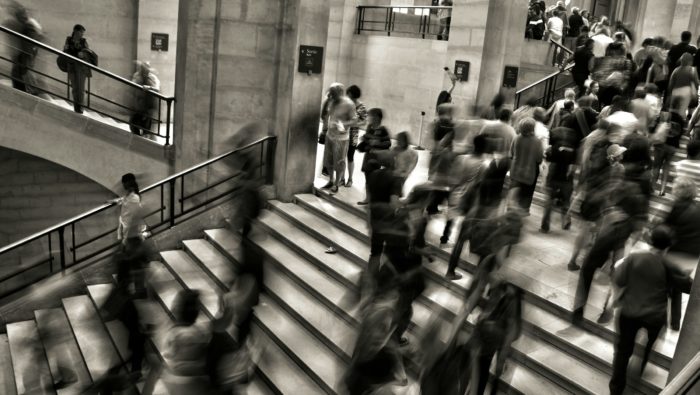
Wandering and Wondering: Coming to Know Place Through Walking Interviews

There is something very human about chatting whilst strolling. In scholarly settings, the act, and art, of ‘walking and talking’ is perhaps most famously associated with Aristotle’s ‘Peripatetics’ school at the Lyceum, near Athens. Indeed, the Greek ‘peripatetikoi’, from which we derive ‘peripatetic’ in English, translates as ‘walking and talking’. Beyond the academy, and particularly for hard conversations, we may purposefully go for a walk so as to speak. At other times, our physical movements seemingly free the mind and tongue in equal measure and conversation naturally flows as a result. Even alone we may pace in order to think through our internal dialogues and disagreements.
To some extent, this illustrates the profound intertwining of mind and body – the inseparability of words and ideas from the fleshier realms of bodies and senses. And yet, despite physical movement being an elemental dimension of human life, as fundamental as thought or speech, it has received a fraction of their scholarly attention. Nevertheless, Socio-Legal scholars have increasingly sought to ask (and answer) questions with reference to embodiment, sensoriality, and the body. This journey towards corporeality – from the body of laws (Corpus Juris) to the law of, and upon, bodies (Jus corporum) – makes a fitting symmetry for a discipline committed to moving beyond textuality.
It is consequently curious, that mobile methods – and especially walking interviews – have yet to be adopted widely in Socio-Legal Studies. Admittedly, I approached the walking interview with scepticism. Despite my own research being centred on physical movement, specifically how we move within the courthouse and how we traverse the court’s antechambers whilst learning, making, and negotiating the law, I feared that the addition of walking to the ‘traditional’, ‘sedentary’ interview might be a contrivance – a passing fad in the fashion long-recognised in the social sciences and legal studies. However, with time, I came to appreciate the sophistication of mobile methodologists’ work, the philosophical depth behind their arguments, and the sensitive variations in their techniques.
Mobile interviewing methods come in many forms and can employ different modes of locomotion. Kusenbach distinguished walking interviews (‘walk-alongs’), from ‘ride-alongs’, and combinations of the two. Others have explored the value of conducting interviews as driver or passenger, whilst cycling, or in wheelchairs. So too there is considerable variety amongst walking interviews, including participatory walking interviews, ‘go-alongs’, or the ‘bimbling’ method. The extent to which there is a planned route – and whether the researcher or participant leads the walk (or perhaps neither) – varies accordingly. As such, the character of the walk can be tailored to fit one’s underlying research questions and the structure of interview selected, for example, an oral history might best be conducted as an unstructured bimble. Furthermore, the degree to which the walk replicates, or breaks from, the participant’s everyday experience is malleable. This allows for investigation of mobile phenomena in a naturalistic fashion, where and as they actually take place. So too, mobility may be introduced to unsettle the everyday, disrupting an ordinarily sedentary practice, such as judging, by walking and talking.
Of course, direct comparison of walking and ‘sedentary’ interviews is inevitable. But rather than treating the former as merely a moving version of the latter, it is better understood as an ‘alternative method’. Firstly, as it combines participant observation and interviewing – at least more explicitly than the sedentary formulation – it has a ‘blended’ or ‘hybrid’ character. Secondly, it is supported by distinct methodological and ontological foundations – open to ‘the dialectic between people and places’, and in turn, to the possibility of crafting methods to interrogate ‘what is the relationship between what people say and where they say it’. This commitment to place, to the ‘meanings’ of places, and place’s interrelationships with temporality, memory, and identity (both individual and group), expresses the phenomenological perspective that place is ‘involved in the action and cannot be divorced from it’.
Although walking interviews are neither better nor worse than sedentary interviews, they are, certainly, different. They foreground embodied ways of knowing and provide researchers a profound immediacy to participants’ experiences, since ‘ideas and emotions are articulated differently first-hand, as opposed to by recall.’ The fruits of this approach are also distinct. Evans and Jones found that through walking interviews the topics of stories told by interviewees were deeply rooted in a sense of place and produced rich geographical narratives. Indeed, as Anderson elaborated, ‘the knowledge produced is importantly different: atmospheres, emotions, reflections and beliefs can be accessed, as well as intellects, rationales and ideologies.’ As such, mobile methods offer new techniques for the study of established topics of inquiry, and equally, open up previously unstudied phenomena to investigation. And for Socio-Legal scholars, in the walking interview, the Peripatetic tradition continues to provide avenues down which to wander and wonder.

